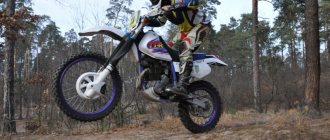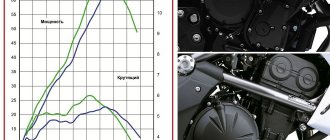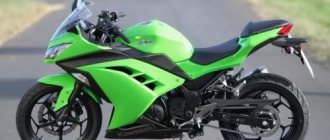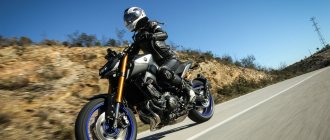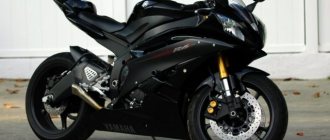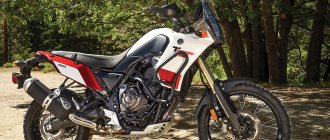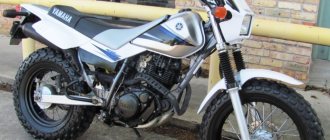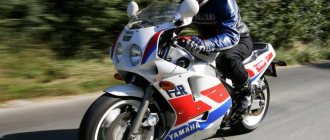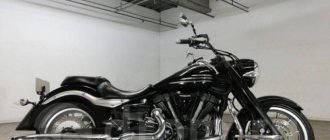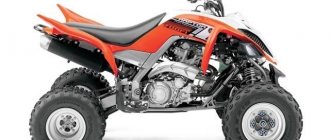| Yamaha FZ8N (2010-2015) | Yamaha FZ8S (FZ8 Fazer) 2010-2015 |
Yamaha FZ8 road motorcycle series
appeared in 2010 (model year - 2011) and replaced the Yamaha FZ6. The model was initially aimed at the markets of North America, Europe, Australia and New Zealand, but after 2013, the Yamaha FZ8 left the North American market, giving way to the Yamaha FZ-09 (MT-09).
The Yamaha FZ8 was based on the frame, engine and swingarm from the flagship model Yamaha FZ-1. The engine volume was reduced to 779 cc, a lightweight crankshaft, smaller valves and different camshafts were installed. As a result, the Yamaha FZ8 engine began to produce 106 hp. power and 82 Nm of torque. The engine pulls confidently at low and medium speeds, and produces maximum performance at 8000-10000 rpm.
Compared to the previous version (Yamaha FZ6), the new Yamaha FZ8 model received a more modern appearance, sportier suspension in the form of an inverted fork (adjustable since 2013) and a rear monoshock absorber, as well as more powerful 4-piston brakes on 310 discs mm. The fuel tank capacity has also changed, which is 17 liters, instead of 19 liters for the FZ6.
The Yamaha FZ8 model was produced until 2021, after which it was discontinued. The successor to the model, as mentioned above, was the Yamaha MT-09.
Main modifications of Yamaha FZ8:
- Yamaha FZ8N / NA (FZ8 Naked)
- a regular naked version without a front fairing. - Yamaha FZ8S/SA (Fazer8)
- version with front fairing and ABS as standard.
Main competitors of Yamaha FZ8:
- Honda VFR800X Crossrunner
- Kawasaki Z800
- Suzuki GSR 750
Brief history of the model
- 2010-2011 - start of production and sales of Yamaha FZ8. This year's motorcycles are presented as 2011 models. This year's models come in blue, dark gray and white.
Model:
Yamaha FZ8-N (Naked) / FZ8-NA, Yamaha FZ8-S Fazer / FZ8-SA (all regions).
Model code:
FZ8NAB, FZ8NACB (North America), 42P2, 39P4, 1BD1, 42P1, 59P1, 39P1 (Europe).
- 2012 - the appearance of a limited edition of Yamaha FZ8 motorcycles in white and red colors in honor of the 50th anniversary of Yamaha Racing. The main colors of motorcycles are dark gray, light gray and white.
Model:
Yamaha FZ8-N (Naked) / FZ8-NA, Yamaha FZ8-S Fazer / FZ8-SA (all regions).
Model code:
FZ8NBG, FZ8NBCG (North America), 42P5, 39PC, 39PB, 39P6, 1BD2, 42P4, 59P2, 59P3, 39P9 (Europe).
- 2013 is the last year of sales in the North American market. The fork becomes adjustable. The primary colors are similar to the previous year, but without the white and red versions.
Model:
Yamaha FZ8-N (Naked) / FZ8-NA, Yamaha FZ8-S Fazer / FZ8-SA (all regions).
Model code:
FZ8NDC, FZ8ND (North America), 42PB, 39PP, 1BD6, 1BD4, 42PE, 42PA, 59P5, 59P6, 39PT, 39PL (Europe).
- 2014 - no significant changes. The FZ8 is no longer available in the North American market.
Model:
Yamaha FZ8-N (Naked) / FZ8-NA, Yamaha FZ8-S Fazer / FZ8-SA (Europe, Oceania).
Model code:
2SH4 (FZ8-N), 59P8 (FZ8-NA); 42PG (FZ8-S), 1BD8 (FZ8-SA)
- 2015 is the final year of production for the Yamaha FZ8.
Model:
Yamaha FZ8-N (Naked) / FZ8-NA, Yamaha FZ8-S Fazer / FZ8-SA (Europe, Oceania).
Model code:
2SH7 (FZ8-N), 59P9 (FZ8-NA); 42PN (FZ8-S), 1BDA (FZ8-SA)
Dimensions and weight
The weight of the motorcycle including fuel is not small, but not too large either, and amounts to 212 kg. The tank volume here is as much as 17 liters, which some may even consider too large. However, if you use a motorcycle for country trips, this volume will be just right, because the average gasoline consumption per 100 km fluctuates around 5 liters. The saddle height is average and reaches 815 mm.
Specifications
Yamaha FZ8 Specifications:
| Model | Yamaha FZ8 |
| Motorcycle type | naked |
| Year of issue | 2010-2015 |
| Frame | aluminum |
| engine's type | 4-cylinder, 4-stroke, in-line |
| Working volume | 779 cm³ |
| Bore/Stroke | 68.0 x 53.6 mm |
| Compression ratio | 12,0:1 |
| Cooling | liquid |
| Number of valves per cylinder | DOHC, 4 valves per cylinder |
| Fuel supply system | electronic fuel injection |
| Ignition type | transistor (TCI) |
| Maximum power | 106.2 hp (78.1 kW) at 10,000 rpm |
| Maximum torque | 82.0 Nm (8.4 kgm) at 8000 rpm |
| Clutch | Multi-disc in oil bath, cable drive |
| Transmission | 6-speed |
| type of drive | chain |
| Front tire size | 120/70ZR 17M/C (58W) |
| Rear tire size | 180/55ZR 17M/C (73W) |
| Front brakes | 2 discs, 310 mm, 4-piston calipers (NA, SA - ABS) |
| Rear brakes | 1 disc, 267 mm, 1-piston caliper (NA, SA - ABS) |
| Front suspension | 43 mm inverted fork (adjustable preload - since 2013), stroke - 130 mm |
| Rear suspension | Pendulum with monoshock absorber (preload adjustment), stroke - 130 mm |
| Overall dimensions (LxWxH) | 2140 x 770 x 1225 mm - Yamaha FZ8-S 2140 x 770 x 1065 mm - Yamaha FZ8-N |
| Seat height | 815 mm |
| Minimum ground clearance (clearance) | 140 mm |
| Wheelbase | 1460 mm |
| Gas tank capacity | 17.0 l (including reserve - 3.4 l) |
| Maximum speed | 221 km/h[1] |
| Acceleration 0-100 km/h (0-60 mph) | 3.51 sec[2] |
| Motorcycle weight (curb) | 212 kg / 217 kg (ABS) - FZ8-N 215 kg / 220 kg (ABS) - FZ8-S |
006-MOTO_0610_015
The silhouette of these legendary brake calipers is more recognizable than any emblem.
The silhouette of these legendary brake calipers is more recognizable than any emblem.
The chassis also shows a clear similarity with the FZ1 - from the frame layout to the same pendulum length as the “liter”. Let's not forget that the Kawa Z750 has a steel frame and is less rigid (this is related to the higher price of Yamaha). The engine is attached to the frame at six points and helps keep it in shape. In general, the layout of the motorcycle is such that the weight distribution along the axles (51% front, 49% rear) provides a good foundation for precise handling. The wheelbase is 1460 mm, like a liter car, which means a spacious seating position not only for the driver, but also for the passenger, and this is beneficial for directional stability. Stopping the car are 310mm front brake discs with monobloc four-piston Advics calipers (formerly known as Sumitomo) and a rear 267mm disc with a two-piston caliper, which complements the engine's considerable stopping torque. It would seem that the chassis is completely identical to that of the liter older brother, but not quite. Here the seat is 12 mm narrower, and the gas tank is “skinnier” in the place under the knees, which reduced its capacity by half a liter - to 17 liters. The FZ1 has a rear tire with a width of 190 mm, but here it is 180. The wheel is narrower, the handling is better, let's go! I guess I'm not a real Englishman - I don't like rain. But I was glad for this damp, gloomy morning in Marseille. Ideal conditions to test the engine in non-limiting modes of medium and low loads, its balance and confidently restrained character. One thing was upsetting: there were no motorcycles with ABS in the test park, and I really wanted to check its performance on wet asphalt. And, I note, I took the raincoat out from under the saddle, replaying in my head the memories of the Z750, devoid of any luggage capacity.
Reviews
Yamaha FZ8 reviews:
Expand Collapse
I drove the FZ8 - I didn’t like it at all, at all. The motor seems to be electric, no pickup, no character. And the very feeling of the motorcycle, how can I explain it - as if it was all assembled from different parts, individual parts are not bad, but there is no whole motorcycle (this is not about frame wobbling or lack of rigidity, everything is fine with that, this is precisely the feeling from motorcycle as a whole).
I think that the FZ6 was much more interesting, even at the same price I would have taken it. Well, the modern Diversion, by the way, is okay, the XJ6 which, and even for a beginner, is more suitable. This is if we talk about the Yamaha line.
I recently purchased this model. Impressive! 4-cylinder engine 779 cm3. It showed itself quite as expected: of course, there can be no talk of high speeds here, but in all other respects it is in no way inferior to the 1000 cc. The price is great so you don't have to overpay for unnecessary power. Beautiful Japanese, without any frills, everything is clear and thought out. I was disappointed that the suspension is not adjustable; this is, of course, inconvenient. Well, I would like the acceleration to be faster, although many argue that it is the same as in the 1000. Overall, it’s a good model, there are no particular disadvantages. The increased power is felt immediately.
I rode this one and really liked it! Powerful, cool car. And, most importantly, reliable. They really didn't skimp on the build quality. The rear swingarm and front suspension are all made of aluminum. Just like in 1000, the design is like two peas in a pod. But the developers didn’t think about adjusting the suspension. It is simply not provided for on a motorcycle. As for the rear shock absorber, that’s also a mistake. In this model, it can only be adjusted by pressing. Good pickup at the level, acceleration is smooth, not at all the same as in 1000. This is clearly a plus. The design is simply top notch! It's immediately obvious that this is a thing. Moreover, it looks quite expensive, you can’t even tell that it was purchased for that price. I like the weight. In the city it is simply an irreplaceable thing!
The Yamaha FZ-8 is a very interesting motorcycle, if only because it belongs to the far from common “eight hundred” category.
Many models have versions with 600 cc engines. cm, but usually they are followed by the flagship “liters”. The FZ-8 was generally born as a replacement for its famous predecessor, the Yamaha FZ-6, although it did not gain popularity. It is quite possible that its price played a role here, higher than for the “six hundred”, with fairly similar characteristics. It is worth noting that the FZ-8 was developed not on the basis of its predecessor, but on the basis of the flagship of the Phaser line, the FZ-1. The “eight hundred” was equipped with a reduced capacity of 779 cubic meters. see engine, smaller valves, lighter crankshaft and different camshafts. Otherwise, the Yamaha FZ-8, when viewed from the side, looks more like the FZ-1 than the FZ-6. And this model is also produced in several versions - “N”, that is, a naked bike, and “S”, that is, a motorcycle with a plastic fairing. This motorcycle has been produced since 2010, competing with models such as the Kawasaki Z800 and Honda CB900F Hornet.
The Yamaha FZ-8 differs from its predecessor in other improvements. Thus, the appearance has become more modern and aggressive, although one can say about the FZ-6 that it looked very attractive. However, the FZ-8 has improved front brakes (4-piston calipers instead of 2-piston) and inverted forks instead of the usual ones. He also got a more modern rear suspension, which had a positive effect on handling and comfort. True, the gas tank capacity was reduced from 19 to 17 liters, but 17 liters is, you see, a very impressive volume for a classic road motorcycle.
So, we figured out the engine - an in-line four with liquid cooling, interlocked with a 6-speed gearbox and fed by an injector. The frame of the motorcycle, like the rest of the Phasers, is aluminum, which is also a plus. The Yamaha FZ-8 produces 106 hp and 82 Nm of torque, with peak power at 10,000 rpm and peak torque at 8,000 rpm. Acceleration from 0-100 km/h in the FZ-8 takes just 3.4 seconds, and the top speed reaches 250 km/h. True, the naked version of the Yamaha FZ-8 will blow away the motorcyclist much earlier - it lacks wind protection as a class.
The impressive dimensions inherited from the liter version make this motorcycle convenient for most riders. Tall people will be quite comfortable on it, but short motorcyclists may have some problems in confidently reaching the ground with both feet. However, what cannot be taken away from the Yamaha FZ-8 is a comfortable seating position - the legs are “under oneself”, the hands rest calmly on the steering wheel, without being subjected to additional load, as on a sportbike, and the wide and comfortable standard seat resembles a sofa.
In reviews there is sometimes an opinion that, they say, the Yamaha FZ-8 is a motorcycle without character, without zest, but it is hardly possible to say this so categorically. Rather, we can say that the FZ-8 is a very well-balanced motorcycle. It is not “tailored” for any particular driving style, you can ride it with equal pleasure and leisurely for your own pleasure, and get an adrenaline rush by squeezing everything it can out of it - and the FZ-8 is capable of a lot. Comparing favorably with the “six hundred” with better low-end traction, it is perfect for those who need the “liter” FZ-1 with its 150 hp. seems overly powerful.
Similar articles:
- Yamaha FZ-1 Review
- Yamaha FZX 250 Zeal review
- Yamaha FJ 1200 Review
- Yamaha MT-10 Review
- Yamaha FZR 750 Genesis Review
- Kawasaki Z750 Review
LiveJournal
Yamaha FZ8 Fazer. For those who understand
The history of Fazer goes back to the last century, or more precisely, to 1998, when this model was born. The first-born was 600, followed by “liter”...
Igor Vladimirov
Yamaha FZ8 Fazer. Price: from 429,000 rub. (approximate price). On sale: since 2011
The history of Fazer goes back to the last century, or more precisely, to 1998, when this model was born. The first-born was 600, followed by “liter”. Now for those who have already grown out of six hundred cubes, but do not want or cannot operate a liter model, Yamaha offers a compromise - FZ8
Motorcycle Yamaha FZ8 Fazer © Photo: Yamaha
In fact, compromise is only about the right to choose. The new FZ8 in variations does not fall under this definition, since in fact it successfully combines the advantages of easy control and a powerful engine. The four-cylinder engine has a displacement of 779 cm3 and a power of 106.2 hp. s., torque - 82 Nm at 8000 min-1. “Dry numbers,” despite the fact that they accurately describe the capabilities of the new engine, in fact cannot convey some of its features. The fact is that the designers tried to very accurately link its characteristics to the operating modes for which the motorcycle itself is designed. What do you need for successful driving in the city? That's right, traction at low and medium speeds. The new product begins to successfully “pull” after the mark on the tachometer corresponding to 1100‑1200 rpm. The engine, the donor of which is the final R1 unit, was slightly rebuilt, changing the diameter of the pistons (the stroke remained the same) and installing a cylinder head not with five valves, but with four (for each cylinder, of course). The new engine does not simply take in air, but through manifold pipes of different lengths, which ensures high torque over a wide speed range. This engine does not have an exhaust valve, which also has its advantages: an extra (in this case) part means extra weight...
Yamaha FZ8 Fazer motorcycle engine © Photo: Yamaha
Despite the fact that the power of the “eight” is slightly greater than the power of the “six hundredth” engine, the difference in displacement, amounting to about 200 “cubes”, ensures good dynamics and the correct response of the engine to the throttle. The weight distribution of the new product is approximately 50/50, with a little more weight on the front wheel and a little less on the rear wheel. With a wheelbase of 1460 mm, this is a good basis for excellent handling of the motorcycle, even if there is a passenger in the back seat. Brakes: front with disc diameter 310 mm, rear - 267 mm. They are quite enough for good deceleration at almost any speed. There are versions with an ABS system, which has recently become, if not a fashionable trend, then at least not an unnecessary gadget that ensures safety, especially on wet surfaces.
Those who often travel outside the metropolis will need a fairing, which, by the way, does a good job of its duties. Without it it will blow through. For more detailed information, please contact your Yamaha representative in Russia (Yamaha Motor CIS) or its dealers.
News Media2

